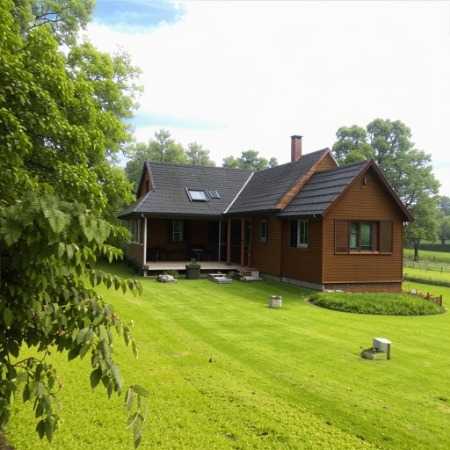The roof is one of the most vital elements of a building, protecting it from atmospheric precipitation, wind, and temperature fluctuations. Over time, roofing materials wear out, leading to leaks, insulation damage, and deterioration of load-bearing structures. Roof repair is a necessary procedure that extends the building’s lifespan, enhances comfort, and prevents more severe problems. In this article, we will explore types of roof repairs, causes of damage, restoration technologies, and essential maintenance recommendations.
Causes of Roof Damage and the Need for Repair
Roofs are exposed to many factors that cause wear and damage over time. The primary causes include mechanical impacts, ultraviolet radiation, temperature fluctuations, and precipitation. Wind loads can cause displacement or destruction of roofing materials, especially in regions prone to storms and hurricanes.
Additionally, improper installation or use of low-quality materials significantly shortens the roof’s service life. Violations of installation technology, lack of waterproofing and ventilation lead to condensation formation and wood rot in structural elements. Snow and ice accumulation in winter add extra load, contributing to deformation and leaks.
Natural material wear is another significant cause, especially for soft roofing and older roofs. Regular inspections and timely repairs help detect and fix defects early, substantially reducing restoration costs.
Types of Roof Repair
Roof repair can be categorized into several main types depending on the nature of damage and work volume. Routine repair involves fixing minor defects such as replacing individual tiles, sealing joints, and stopping leaks. This repair is usually done regularly and does not require significant expenses.
Capital repair includes full or partial replacement of roofing, restoration of waterproofing, insulation, and structural elements. This type is necessary for severe damage, substantial material wear, or building reconstruction. Capital repair demands professional expertise and careful planning.
Soft roof repair has its peculiarities related to material characteristics — roll or membrane coverings. It is crucial to identify the damage cause correctly and select compatible materials to restore waterproofing. Often, local patching or complete covering renewal is applied.
Repair Technologies and Materials
The choice of repair technology depends on roof type, damage extent, and climate conditions. Metal roof repairs often involve welding, sheet replacement, or seam sealing with special mastics. Metal roofs are durable but require regular maintenance to prevent corrosion.
Tile roofs are repaired by replacing damaged elements, restoring fasteners, and treating wooden components with antiseptics. Maintaining the cover’s integrity and proper water drainage is essential. Sometimes, the underlayment and insulation are restored.
Soft roofs use bituminous mastics, polymer membranes, and repair patches. Ensuring quality waterproofing and UV protection is vital. Modern materials allow quick and effective repairs, extending roof lifespan.
Roof Repair Stages
The first stage is a thorough inspection and diagnosis of the roof condition. Damaged areas, material wear, structural and waterproofing status are identified. Specialists often use equipment like thermal imagers and drones.
Next, a work plan is developed, and materials matching the roof type and operating conditions are selected. Capital repairs may require old covering removal and base preparation. Special attention is paid to ventilation and proper waterproofing layer installation.
After base preparation, new covering installation or damaged element restoration is performed. Adherence to installation technologies and manufacturer recommendations is crucial. The final stage includes quality checks and defect elimination.
Repair Features Depending on Roof Type
Sloped roof repairs have specifics related to pitch and covering type. Ensuring joint tightness and proper water drainage is vital. Attic roof repairs focus on insulation and vapor barriers to prevent condensation.
Flat roofs require strict control over waterproofing and ventilation. Multilayer systems with bituminous or polymer membranes are common. Repairs include leak elimination, drainage system restoration, and base reinforcement.
Metal tile roofs need regular fastener checks and anti-corrosion treatment. Repairs must avoid damaging the covering and ensure connection durability. Sometimes, local sheet replacement or full reconstruction is performed.
Maintenance and Preventive Care Tips
To prolong roof life, regular inspections and minor defect repairs are essential. Clearing debris, leaves, and snow prevents moisture buildup and corrosion. Monitoring drainage systems and ventilation is also important.
Leaks should be addressed promptly to avoid damage to internal structures and finishes. Using quality materials and professional installation reduces problem risks.
Preventive maintenance includes antiseptic treatment, waterproofing renewal, and fastener checks. Regular technical service ensures roof durability and reliability.
Comparison Table of Roof Repair Methods
| Repair Method | Application | Advantages | Disadvantages |
|---|---|---|---|
| Local Repair | Minor damages | Quick defect elimination | Not suitable for extensive damage |
| Replacement of Elements | Tiles, metal sheets | Preserves main covering | Requires skill and care |
| Capital Repair | Severe wear, reconstruction | Complete roof restoration | High cost and time-consuming |
| Soft Roof Repair | Roll coverings | Waterproofing and quick restoration | Limited patch lifespan |

